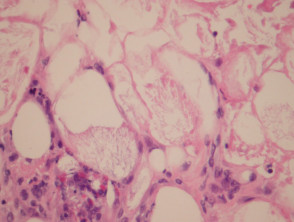Poststeroid panniculitis is a rare complication of systemic corticosteroid therapy. Clinically, erythematous nodules and indurated plaques develop on the cheeks of children within days or weeks following rapid systemic steroid tapering or cessation.
Histology of poststeroid panniculitis
Poststeroid panniculitis presents as lobular panniculitis with a mixed inflammatory infiltrates without vasculitis. Needle-shaped crystals within adipocytes are characteristic (figure 1). The clefts may be surrounded by foreign body giant cells.
Poststeroid panniculitis pathology
Special studies for poststeroid panniculitis
None are generally needed.
Differential diagnosis of poststeroid panniculitis
The clinical history of abrupt steroid withdrawal is helpful.
Sclerema neonatorum — This shows identical crystals but there is minimal associated infiltrate or reaction.
Subcutaneous fat necrosis of the newborn — This can be histologically identical and may need clinical correlation for confident distinction
